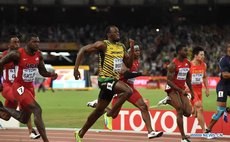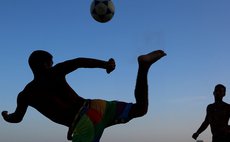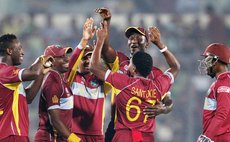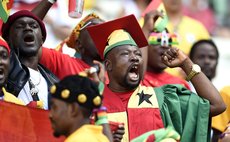School Days Were Happy Happy Days
A happy sight caught my eye on the morning of Monday 14th April. It was that of Dominica Grammar School—house by house—making their way along the new road at the back of the Sports stadium en route to Pottersville for the school's annual sports day. The scene put me in mind of the aspects of transformation which have taken place. Without prejudging the issue, it would seem the mass exodus may have been aimed at ensuring full representative attendance at the event. My arrival at Pottersville at around one p.m. meant that I had missed the action completely and everything was packing up. Even earlier I had missed St. Mary's Academy whose stream of races etc had wound up a bit earlier at Botanic Gardens.
The riot of colourful house uniforms in each case reminded me that in my time at school we had no colours to differentiate our houses at D.G.S. Everybody wore white. Only red and blue and chocolate ribbons provided faint mark of identity as to specific houses. At first, there were only two houses: Set 'A' and Set 'B'. Later as the school grew in numbers of its students the number of houses grew to the present Skinner, Dawbiney, Dupigny and Benedict Joseph houses.
Skinner is in memory of the founding headmaster and Benedict Joseph commemorates a schoolboy of good public spirit who died while at school. The name Dawbiney marks the respect pertaining to the great benefactor who not only donated the old public market in Roseau and a ward at the old Roseau Hospital, but also contributed a building to house Dominica Grammar School when it started with only about ten or twelve students more than one hundred years ago.
To apprise readers of the stark difference between my days at D.G.S. and the present setting, it suffices somewhat to state that the full attendance when I entered that hallowed portal was eighty-four boys. And girls did not come into the picture until in the Seventies.
Sports Day at DGS was a big thing in Dominican society. It did not end at one o'clock and went into near dark, and the roar from Windsor Park carried to the Bayfront in Roseau. Pole vault, no longer included in the activities, drew gasps of excitement and the relay race evoked near delirium. Don't talk about the tug o'war for which a big cake was assigned to the winning team. Similarly, the champion house was inspired by the presence of the other prized cake.
Glancing at a few of the results of the D.G.S. event at Pottersville—where the venue was parched, dry and dusty—the boys 200 metres was won in 32.35 seconds by John Gregoire in the Under 14 category. The girl's Under 14 went to Jeanne Seraphin with 32.73 seconds. The 400 metres revealed times of between 60 seconds and 65 seconds and suggests that students were doing this event a good deal faster several years ago when it is gathered that Ivan Shillingford, later to become a famed Dominica Cricket captain, had set a record of 55 seconds for the quarter mile.
As a benchmark for excellence we can take the 800 metres in which the current day marks are quoted at between 2 minutes 41 seconds and 2 minutes 50 seconds for the boys and correspondingly slower for the girls.
If patriotically anyone is inclined to ask where our crop of Olympians are to emerge, my response first to establish the true extent of the comparative positions and then to look at a possible way forward. It was heartening to note that in the eighties Bruce Phillip, a student of the Dominica Grammar School took second place but tied with the same time to the Jamaican winner in the Carifta Games in Barbados. Stephen Agar of St. Mary's Academy took the silver medal at the same games in the 5,000 metres, and his schoolmate Cedric Harris shone in the 800 metres.
Bruce Phillip went on to feature as premiere 400 metres runner in the U.S.A. among college students. Later, it is common knowledge that Jerome Romain and Dawn Williams-Sewer, both of whom were products of Portsmouth Seconddary School, came close to distinguishing themselves in the 1996 Olympic Games, Romain in the triple jump and Williams-Sewer in the women's 800 metres. The two were world class athletes coming up through the school's system—primary up to secondary. The question is what happened then but now is not happening.
Evoking a high degree of laughter at the time was a suggestion by the DGS headmaster of the late-Forties to the effect that a middle or long distance runner was better off drinking quantities of milk supported by adequate rest rather than pursuing a strenuous running programme! This was tantamount to good luck attending any such runner by way of all the other contestants falling on their faces several times!
My good friend and athletic coach Emanuel Loblack would be horribly flabbergasted by the late headmaster's recipe for track prowess. Loblack will be the first to tell anyone willing to listen that a prime requirement in this day and age is a standard synthetic track where our budding athletes can be adequately trained. Talent we do have. Potential is not in short supply. Yet, if the needed facilities are not available we can't get anywhere in the modern sporting world. Maybe such a void might answer the present situation of school athletic meets contracting to a couple of hours instead of expanding to two days or more.




